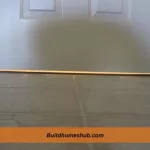Shingles are a common type of roofing material designed to provide a protective layer over the roof deck of a house. While shingles are typically installed using nails or staples, some people may wonder: are shingles supposed to be glued down? In this article, we will explore the proper installation methods for shingles and why it is generally not recommended to use glue when installing them.
Are Shingles Supposed to Be Glued Down?
No, shingles are typically not meant to be glued down. Instead, they are installed using nails or staples to secure them to the roof deck. The shingles are overlapped and fastened in a specific pattern, with each course of shingles offset from the one below it to create a weathertight seal.
The shingles are also coated with asphalt or another adhesive material to help them stick together and prevent wind uplift. This adhesive coating is activated by the heat of the sun, which causes the shingles to seal together and form a solid layer.
It is not recommended to use glue to install shingles. This can weaken the adhesive coating and cause the shingles to come loose or blow off in high winds. It is important to follow the manufacturer’s instructions for installing shingles. And, use the recommended fastening method to ensure a secure and long-lasting roof.
How Do You Hold Down Shingles?
Shingles are typically held down using nails or staples. The specific type of fastener used and the spacing of the nails or staples will depend on the type of shingle being installed and the manufacturer’s recommendations.
To install shingles, the first step is to prepare the roof deck by removing any old roofing material and making any necessary repairs. Then, a layer of underlayment is installed over the roof deck to provide additional protection against moisture.
Next, the shingles are installed in a specific pattern, with each course of shingles offset from the one below it. The shingles are then secured to the roof deck using nails or staples. The fasteners are placed through the tabs on the shingles and into the roof deck, with the heads of the nails or staples covered by the next course of shingles.
It is important to follow the manufacturer’s instructions for installing shingles and use the recommended fastening method to ensure a secure and long-lasting roof.
The Potential Consequences of Using Glue to Install Shingles
Using glue to install shingles can have several negative consequences:
1. Reduced adhesive strength
Shingles are coated with asphalt or another adhesive material to help them stick together and prevent wind uplift. This adhesive coating is activated by the heat of the sun, which causes the shingles to seal together and form a solid layer.
If glue is applied over the top of the shingles, it can weaken the adhesive coating and reduce the shingles’ ability to stick together. This can make the roof more prone to wind uplift and damage.
2. Increased risk of leaks
If the shingles are not properly secured to the roof deck, they can come loose or shift out of place. This can create gaps or spaces between the shingles, allowing water to leak through and cause damage to the roof and other parts of the home.
3. Voiding of the manufacturer’s warranty
Many shingle manufacturers include a warranty with their products that covers defects or issues that arise during the warranty period. Using glue to install shingles can void the manufacturer’s warranty, meaning that the homeowner will not be covered if any issues arise with the roof.
4. Reduced lifespan of the roof
Properly installed shingles can last for 20-30 years or more, depending on the type of shingle and the climate. If shingles are not properly secured to the roof deck, they may come loose or blow off in high winds, requiring premature replacement. This can increase the cost of maintaining the roof and may result in a shorter lifespan for the roof overall.
The Advantages and Disadvantages of Using Nails or Staples to Secure Shingles
Here are some advantages and disadvantages of using nails or staples to secure shingles:
Advantages of using nails
1. Stronger hold
Nails tend to have a stronger hold than staples, which can make them more effective at securing the shingles to the roof deck. This can help prevent wind uplift and keep the shingles in place during extreme weather conditions.
2. Longer lifespan
Nails are less prone to rusting or breaking than staples, which can make them more durable and longer-lasting. This can help extend the lifespan of the roof and reduce the need for repairs or maintenance.
Disadvantages of using nails
1. More time-consuming to install
Installing shingles with nails can be more time-consuming than using staples, as each nail needs to be individually placed and driven into the roof deck.
2. Increased risk of injury
Using a hammer to install nails can pose a risk of injury, as the hammer can slip and cause accidental impact to the hand or fingers.
Advantages of using staples
1. Faster installation
Installing shingles with staples is generally faster than using nails, as staples can be applied using a pneumatic staple gun, which allows for rapid installation.
2. Reduced risk of injury
Using a staple gun to install staples is generally less risky than using a hammer to install nails, as the staple gun is less likely to cause accidental impact to the hand or fingers.
Disadvantages of using staples
1. Weaker hold
Staples tend to have a weaker hold than nails, which can make them less effective at securing the shingles to the roof deck. This can increase the risk of wind uplift and damage to the shingles.
2. Shorter lifespan
Staples are more prone to rusting or breaking than nails, which can reduce their lifespan and increase the need for repairs or maintenance.
The Proper Installation Methods for Different Types of Shingles
The proper installation methods for different types of shingles may vary slightly, depending on the specific product and the manufacturer’s recommendations. Here are some general steps for installing shingles:
1. Prepare the roof deck
Remove any old roofing material and make any necessary repairs to the roof deck. Install a layer of underlayment to provide additional protection against moisture.
2. Install the starter course
Begin by installing the starter course of shingles along the eaves of the roof. The starter course should be installed with the cutouts (or “notches”) facing towards the eaves, with the shingles overlapping the drip edge. Secure the starter course using nails or staples, following the manufacturer’s recommendations for spacing.
3. Install the rest of the shingles
Continue installing the shingles by working your way up the roof, laying each course of shingles on top of the one below it. Offset the shingles so that the joints between each course do not line up. Secure the shingles to the roof deck using nails or staples, following the manufacturer’s recommendations for spacing.
4. Install the ridge cap shingles
Once all of the shingles have been installed, finish the roof by installing the ridge cap shingles along the peak of the roof. The ridge cap shingles should be installed with the cutouts facing toward the peak of the roof, with the shingles overlapping the ridge. Secure the ridge cap shingles using nails or staples, following the manufacturer’s recommendations for spacing.
How to Glue Down Loose Roof Shingles
To repair or replace shingles that have come loose or been damaged, you will need the following tools and materials:
- Roofing nails
- Roofing cement or roofing tar
- Hammer
- Ladder
- Asphalt shingles (if replacing damaged shingles)
- Pry bar (optional)
Here are the steps to follow:
Locate the damaged or loose shingles. If you are replacing a shingle, you will need to remove the damaged shingle by lifting it up and pulling it out. If the shingle is only loose, you can simply reattach it by nailing it down.
Once the damaged or loose shingle has been removed or reattached, you will need to seal it in place with roofing cement or roofing tar. Use a putty knife to apply a generous amount of the sealant to the underside of the shingle, then press it firmly into place.
To hold the shingle in place, use roofing nails to secure it to the roof. Drive the nails through the shingle and into the roof decking, making sure to leave about 1/4 inch of the nail exposed.
If you are replacing a shingle, you will need to trim it to fit the space left by the damaged shingle. Cut the shingle to the proper size and apply a layer of roofing cement or roofing tar to the underside of the shingle, then press it into place. Secure it to the roof with roofing nails, as described above.
Remember to use caution when working on the roof, and follow all safety guidelines and recommendations. If you are not comfortable or experienced with roofing work, it is best to hire a professional to handle the repair or replacement of your shingles.
Final Thoughts
Whether or not shingles are supposed to be glued down depends on the type of shingles you are using and the condition of your roof. Some types of shingles are designed to be secured to the roof with nails and do not require any additional adhesive. In these cases, applying glue to the shingles could cause them to come loose or fail prematurely.
However, in some cases, it may be necessary to use roofing cement or roofing tar to hold the shingles in place. It is important to follow the recommendations of a professional roofer when determining whether or not to use adhesive on your shingles.
I like to think I can help you with all the information you need on home renovations and DIY tips. You should subscribe.











